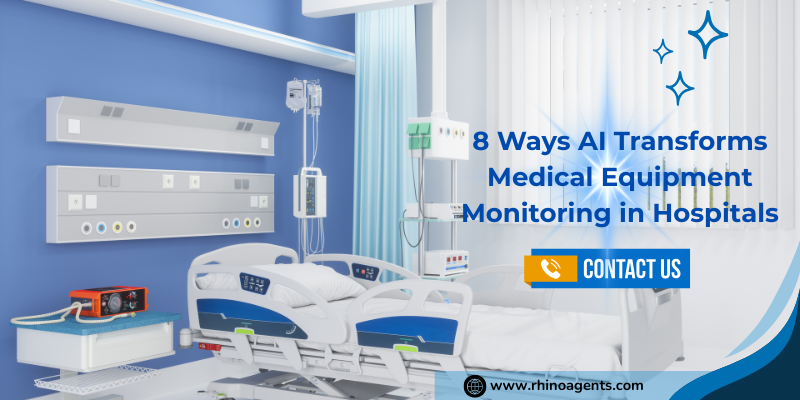In today’s high-tech healthcare environment, medical equipment forms the backbone of patient care. From ventilators and ECG machines to infusion pumps and imaging devices, hospitals rely on complex machines that must function flawlessly 24 hours a day.
Yet, managing the performance, maintenance, and availability of such devices is a massive logistical challenge, especially for large or multi-location hospitals. This is where artificial intelligence (AI) is proving to be a game-changer.
The AI medical equipment monitoring agent uses machine learning and real-time data to provide actionable insights, automate diagnostics, and ensure seamless operation of medical assets.
8 Transformative Ways AI Is Revolutionizing Healthcare Operations in Hospitals
1. Predictive Maintenance with AI Algorithms
Traditional reactive maintenance—fixing machines when they break—is costly and risky. Scheduled preventive maintenance helps, but often lacks efficiency. AI offers a smarter alternative: predictive maintenance.
Using historical and real-time sensor data, AI can predict failures before they occur. This is crucial for equipment like CT scanners, dialysis machines, and anesthesia systems. An AI agent tracks performance deviations, such as overheating or irregular vibrations, and alerts engineers in advance.
Fact: Predictive maintenance reduces maintenance costs by 18-25% and unplanned downtime by 50-70%.
2. Real-time Performance Monitoring of Devices
AI agents continuously assess the operational state of each machine. Whether it’s battery life in portable ultrasound machines or calibration data from infusion pumps, every parameter is tracked and analyzed in real-time.
This level of visibility allows hospitals to prevent small issues from escalating into critical malfunctions, especially in emergency or ICU monitoring settings.
3. Remote Monitoring and Smart Diagnostics
AI-powered dashboards enable hospital technicians to monitor equipment across departments or even entire hospital networks remotely. This helps reduce the need for in-person inspections and allows for faster troubleshooting.
Remote diagnostics are particularly helpful during emergencies, such as the COVID-19 pandemic, when physical access to equipment is restricted. According to reports by the WHO.
4. Intelligent Asset Tracking with IoT + AI
AI integrates with RFID, IoT sensors, and hospital asset management systems to track device location, usage frequency, and maintenance status. This allows hospitals to monitor idle assets, identify overused equipment, and make better purchasing or redistribution decisions.
This is a game changer for large hospitals where mobile devices often go missing or sit unused.
Fact: Research shows that between 10% and 20% of a hospital’s budget is lost up to $3,000 per bed annually due to misplaced or underutilized assets.
5. AI-Enabled Compliance and Reporting
Keeping medical equipment in line with regulatory standards is non-negotiable. Manual record-keeping is time-consuming and error-prone. AI agents automate the documentation of performance logs, calibration records, service schedules, and user access logs, ensuring full audit readiness.
Hospitals can instantly generate digital compliance reports aligned with FDA, ISO, or hospital accreditation requirements.
6. Error Reduction in Manual Processes
Human error in logging maintenance events, skipping scheduled checks, or inputting wrong parameters can compromise patient safety. AI automates and verifies these workflows. From assigning maintenance tickets to verifying calibration, every step is traceable and error-resistant.
According to the source NCBI: Human error in Healthcare maintenance, AI-based alerts also help identify if a piece of equipment is operating outside safe limits before it’s too late.
7. Lifecycle Management and Capital Planning
One of the most overlooked uses of AI in hospitals is lifecycle asset planning. AI medical equipment monitoring agents can identify which devices are approaching end-of-life, not just based on age but based on usage efficiency, repair history, and criticality.
Hospitals can plan replacements, allocate budgets, and schedule decommissioning more effectively, ensuring minimal disruption and a better return on investment (ROI).
Stat: Equipment lifecycle tracking using AI can improve capital efficiency by 20–30%.
8. Seamless Integration with Hospital Information Systems
Modern AI agents are built for interoperability. They sync with Electronic Health Records (EHRs), Computerized Maintenance Management Systems (CMMS), Procurement Systems, and more.
For example, if a ventilator is used on a patient during surgery, that data is automatically logged into the EHR, and the AI agent triggers post-use diagnostics.
Such seamless integration creates a data-rich hospital ecosystem where insights flow in real time and administrative burdens are reduced.
Future Outlook: What’s Next?
As AI continues to evolve, medical equipment monitoring will likely incorporate generative AI models, natural language interaction for diagnostics, and even autonomous robotic maintenance assistants. The shift is not just toward monitoring, but toward knowledgeable, self-managing hospital systems.
Hospitals that adopt these technologies now are setting themselves up for greater scalability, resilience, and safety in the years ahead.
Conclusion
The AI medical equipment monitoring agent is not a futuristic luxury—it’s a necessity of today. With hospitals under pressure to maximize efficiency, reduce risk, and maintain round-the-clock performance, AI offers the intelligence and automation needed to succeed.
From predictive maintenance and asset tracking to compliance and remote diagnostics, these agents are redefining biomedical engineering and operational excellence in healthcare.
If your hospital aims to be future-ready, now is the time to adopt smart equipment monitoring powered by AI.
About RhinoAgents
Rhinoagents is a leading platform that offers AI-powered agents to automate workflows in healthcare, retail, finance, HR, and education. Our Medical Equipment Monitoring AI Agent is specifically designed to empower hospitals with smart diagnostics, real-time device monitoring, and compliance automation.
At RhinoAgents:
- All integrations are connected via robust APIs.
- You can format both request payloads and responses flexibly.
- We support RAG (Retrieval-Augmented Generation) as a node.
- Agents can be created using custom prompts or through our no-code UI builder.
- Workflows are fully configurable to your operational needs.
- Every action is logged through our job system for maximum transparency.
Our goal is to provide modular, scalable, and intelligent AI agents that simplify complex operations, helping institutions focus on what truly matters: quality outcomes.
